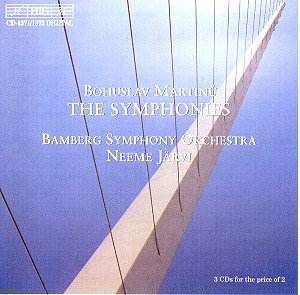Martinů's
symphonies are products of the New World into which he was catapulted
by the spread of Nazi domination across Europe. Their premiere
details reflect this with first airings for three in Boston (1,
3 and 6), one in Philadelphia (4), one in Cleveland (3) and only
one, No. 5, in Prague. The Fifth was in fact dedicated to the
Czech Philharmonic in which he had played during his youth. He
seems to have been embraced euphorically by the United States'
musical establishment; emphatically not the experience of all
refugee composers of the late 1930s into the 1940s.
The
symphonies are works of clamant Czech flavour. It is a tribute
to the composer that his writing, which in its maturity is hardly
ever confusable with any other composer's, helped define Czech
musical character. Would it have had such reach and potency without
the cruel alembic of isolation? Certainly exile and the homeland's
tragic experience of Nazi, then Soviet, invasion chased out the
neo-classical desert that crept into many of his Parisian works.
The
mood of the works is wide-ranging from the epic of the First through
the louring tragedy of the Second, the impacted conflict of the
Third with its finale written with the Normandy landings in mind.
The glum punctuation of the Third's orchestral piano in the finale
deprives the listener of all consolation. Then there is the joyful
depth, intelligent optimism, nocturnal chase, radiance and euphoria
of the Fourth, the pastoral idylls of the Fifth and the surreal
wave-buzzing lambency of the Sixth. The First Symphony is notable
in this version for its sinewy, tense, sprung yet pliantly yielding
textures lit by piano points. The woodwind sing out in delightful
eloquence in Järvi's ‘take’ on Symphony No. 2 (try 00.41
in tr.5 movement 1) and in last movement there is a wonderful
sense of release, joy and liberation. The Fourth is slightly less
easily flowing than the Turnovsky (Apex) or the Neumann (Supraphon)
but in the energised and buoyant finale Järvi captures heart-ease
with a great sense of onrushing flood-tide.
Of
course you could still buy these CDs separately. Losses and Gains?
You save some shelf space with the double width box. You save
money (3 for 2). You lose the Martinů and Policka photos
on the original booklets as well as the composer's endearing caricatures.
A small price to pay. I did a scatter-sampling of comparisons
between the original discs CD362, CD363 and CD402 and their counterparts
in the new box. I could detect no distinction.
Bis's
Bamberg sound is powerful yet with woodwind voices rising fragrantly
or with optimistic character. The Bamberg strings do not radiate
the last word in luxury though neither are they in any way harsh.
The
competition is various. No-one offers all six symphonies for the
price of 2CDs. Well, it is true that you could opt for the Naxos/Ukraine/Fagen
series but much as it saddens me to say so they are not in the
running. Fagen’s Fourth is dreadfully underpowered and earth-bound.
There is the 3CD set from Chandos (Bryden Thomson) to consider
though it will cost you more than the Bis. I have not heard it
so cannot comment on audio and performance values; other commentators
have high praise for the set so it might well be worth auditioning.
Neumann and the Czech Phil on Supraphon in late analogue is excellent
but that box is still at full price. Part cycles include the superbly
recorded First, Fourth and Sixth of Bĕlohlávek on
Chandos. In the Fourth Symphony stakes the Apex CD (Czech Phil/Martin
Turnovsky) complete with 1960s sound, wipes the floor with all
the competition.
This
Bis box is quite a bargain, well annotated by Stig Jacobsson with
good-to-excellent performances and virile sound to match. If anything,
and it is the finest of shadings, Järvi accentuates the power
rather than the poetry. It really is a very close call though
between Neumann and Järvi.
Rob
Barnett
